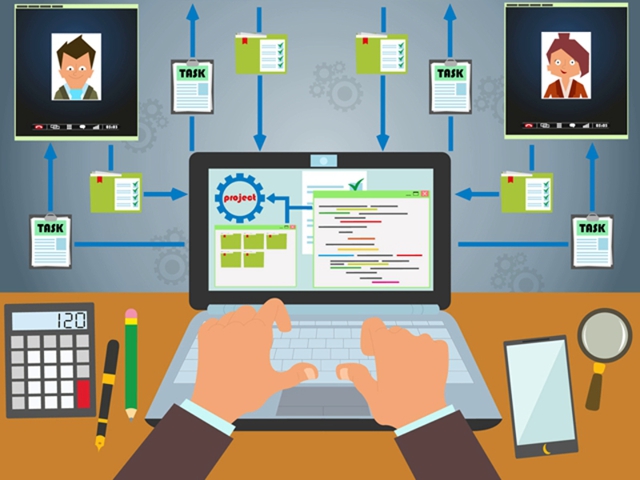COVID-19 has forced billions of organizations around the world to adopt remote work policies. The transition has led to a rapid increase in demand for tools to support remote teams and workflows.
Some software has already experienced a dramatic boost – Zoom users jumped from 10 million to 200 million in a mere three months.
While there are certainly challenges involved in going fully remote, software is helping facilitate communication, collaboration, data access, and people management.
One of the most impactful software right now is Unified Endpoint Management (UEM), which helps businesses organize and control internet-enabled devices from a single interface.
According to a report by Cisco, there are 50 billion connected devices in the world. Technology is integral for staff to efficiently operate at a distance, however, UEM is just as important to secure such devices, as well as company data.
Here’s how UEM is actively supporting remote teams amid COVID-19.
Securing and automating remote work process
Remote teams pose a big risk to sensitive company information. Log-in details, financial details, and correspondence are more vulnerable if shared via personal internet connections that have not been confirmed as secure.
UEM provides 360-degree protection for all corporate data, apps, and devices. Passcodes, device and disk encryption provide physical device security and prevent unauthorized access to devices.
Identity and access management helps determine what resources should be available to which user, as well as ensures specific resources aren’t shared without permission.
Other features include restrictions that limit the device usage to focus only on work tasks, internet security that blocks malicious websites, managed domains that stop emails from unwanted domains from being opened, and blacklist apps that prevent unwanted apps being installed.
Most UEMs also have mobile threat detection integrations to identify and thwart potential vulnerabilities and attacks across devices. Even better, UEM can scan and confirm how compliant devices are at any time, plus take responsive measures to improve compliance.
UEMs automate certain processes to create a streamlined workflow too. Apple Business Manager, Android Enterprise, Samsung KNOX, and zero-touch enrollment can provide advanced features to enroll, secure, and manage devices company-wide.
Not to mention, third-party software like Dropbox, Slack, and Zendesk can be synchronized to have all employee tools centralized.
Providing access to corporate resources
Remote teams need to have easy, constant access to corporate resources to carry out their daily tasks. They also need access to resources that provide information on any changes a company enacts during COVID-19.
One of the biggest perks of UEM is that virtual private networks (VPNs) can be configured and applied to remote devices.
The pandemic has already caused a surge in VPNs, as companies use the technology to protect employee connections to corporate data and resources. Some VPN providers have even reported a 165 percent spike in use since March.
UEM can enable quick and safe distribution of resources like enterprise apps and files to all devices. Similarly, users can be grouped based on their team or project, so data can be easily targeted toward the right people, and users don’t get lost among different channels and storage spaces.
A particularly great quality of UEM is that dynamic grouping automates how groups are made, applying configurations that detect who belongs in what group and needs what materials.
Separate to shared resources, UEM can assign emails, calendars, and contacts to users, meaning all necessary information is immediately attached to profiles – saving time and providing employees with a complete database for communication.
Equally, conferencing and instant-message apps like Slack and Webex can be distributed to devices on-demand.
Remote management and support
Having teams physically separated means employees cannot simply walk to IT departments and ask for help. Instead, they need a dedicated support system that is always available to deal with issues.
UEM makes remote troubleshooting possible via real-time screen-sharing and device control. Users can report problems through an online ticketing system, and then be attended to virtually – IT staff can even freeze and take over devices to get a first-hand look at the situation.
Support teams can then instantly send missing or required fixes to the device, minimizing the time that remote employees are unable to use their hardware.
Another benefit is that UEM can track and locate devices at any time.
If a device is stolen or lost, steps can be taken to block all access and prevent data being hacked. Likewise, devices can be completely removed from management or made unusable by enacting ‘lost mode’ if there are concerns over compromised devices.
Implement BYOD without interrupting user privacy
During COVID-19, businesses have to acknowledge that employees are likely to use their personal devices for work – something that can pose a threat to overall security and corporate data. That said, bring-your-own-device (BYOD) capabilities are supported with UEM.
Employees who use their own mobiles, laptops, or tablets for work tasks can do so without being liable to cyber attacks.
UEM creates separate containers for work data and apps on personal devices; these containers provide the same level of protection that a corporate-issued device would have.
Restrictions can additionally be enforced to ensure that no professional data can be opened in an unmanaged or personal app outside of the container.
The combination of such containerisation with frequent corporate data monitoring, plus mobile threat defence software, forms an extremely tight network that prevents data loss.
An added bonus is that, if an employee leaves the company or the UEM software expires, BYODs can be selectively wiped in order to remove corporate data and still keep personal data.
This type of curated management means employees have a wider choice of the hardware they use, without the threat of losing their personal information or jeopardizing the business.
Beyond COVID-19
Unified endpoint management is proving to be extremely valuable among the COVID-19 outbreak.
Not only does the software automate work processes, provide greater access to resources and networks, offer remote support, and implement BYOD, it is shaping the future of work after the pandemic subsides.
Technology like UEM shows that teams who previously thought they were unable to work remotely, can actually do so.
Moreover, they can operate extremely effectively and keep data secure.
As more businesses are forced to experiment with different ways of coping during quarantine, UEM is poised to be a long-term solution that facilitates more flexible, efficient, and safe working.
Disclosure: This story is brought to you through an ESPACIO portfolio company.
4 SaaS platforms helping companies transition to remote work











